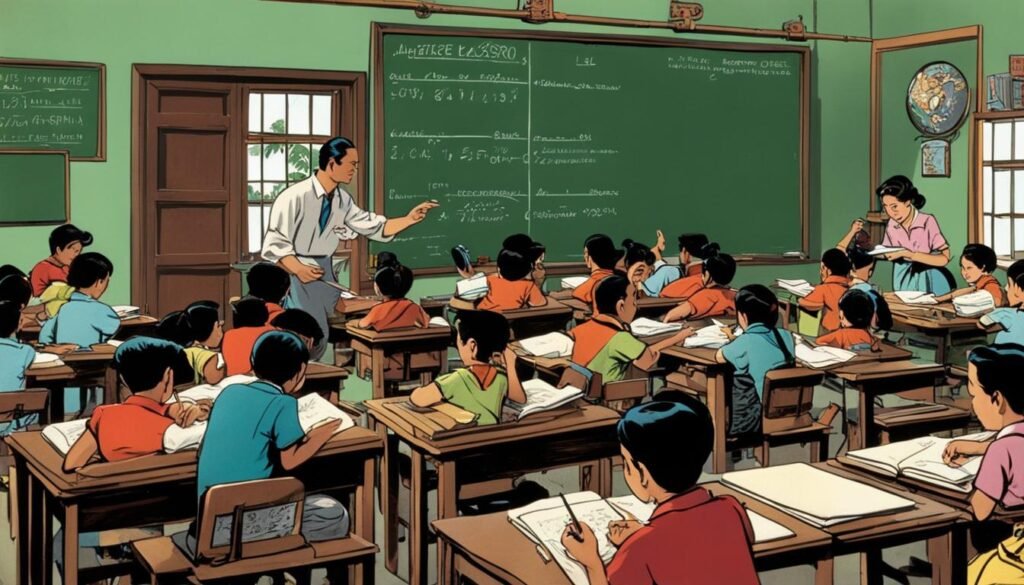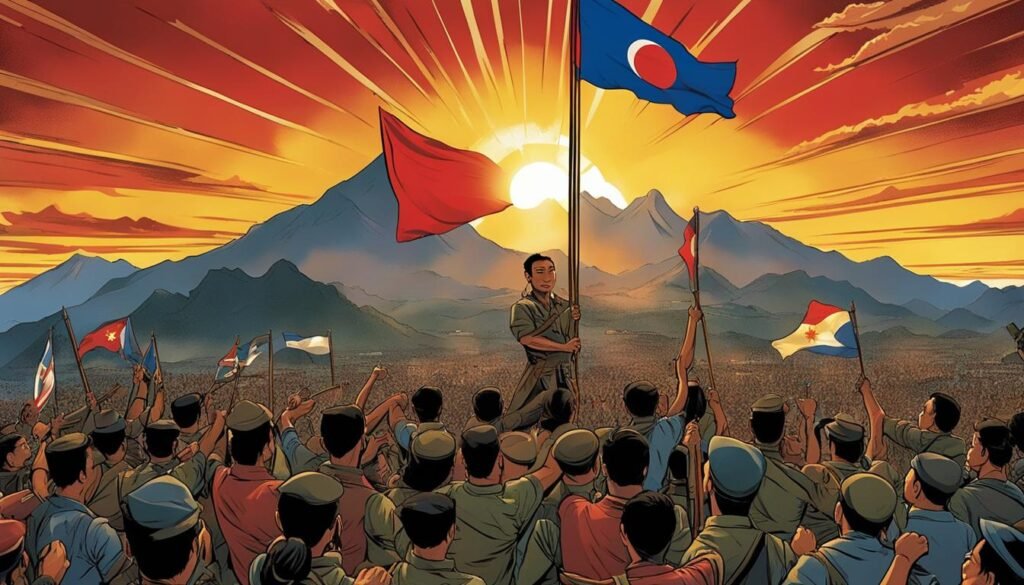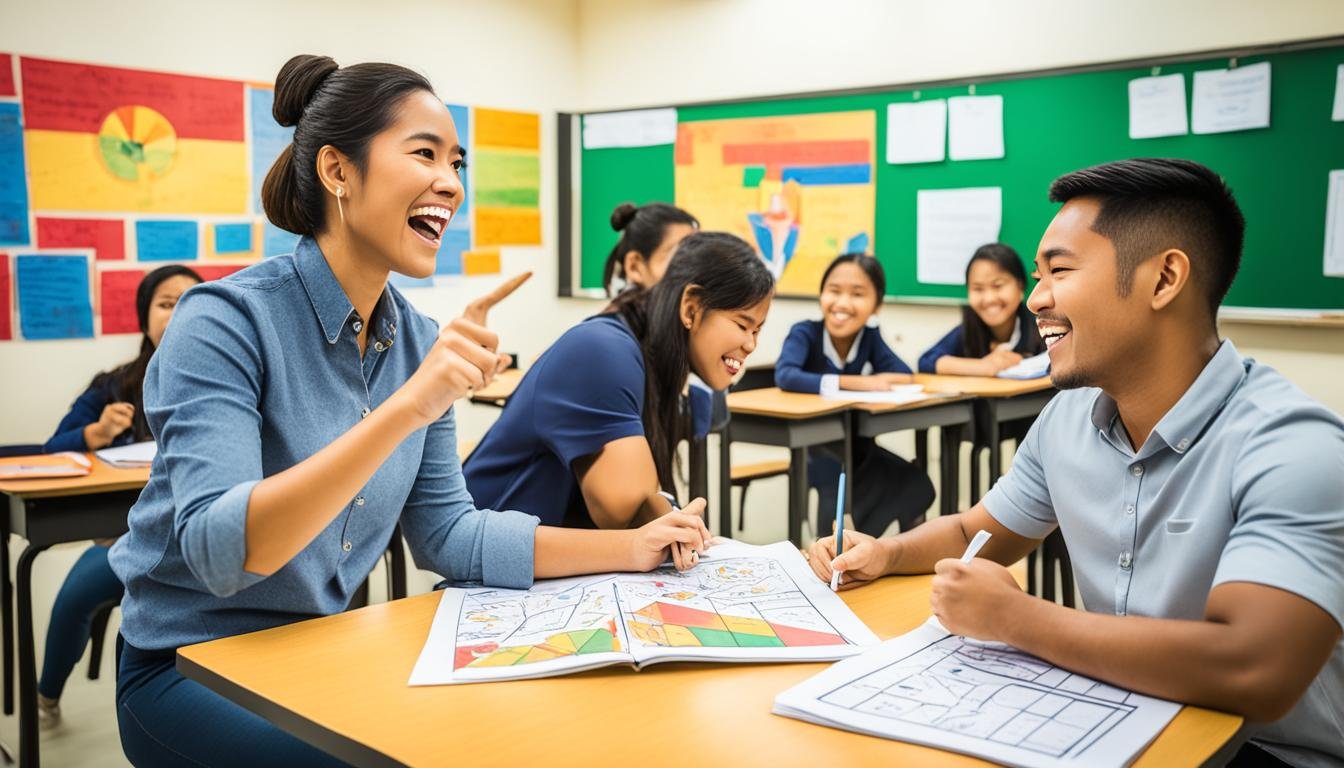The post-war years from 1946 to 1972 were a significant period of cultural and educational reforms in the Philippines. These reforms aimed to shape Filipino cultural identity and transform the Philippine educational system to meet the needs of a developing nation.
Under Japanese occupation during World War II, the educational system underwent significant changes as the Japanese military administration sought to promote Asian cultural values and diminish Western influence. After the war, the Philippines embarked on a journey of rebuilding, establishing the Department of Education and Culture in 1947 to oversee the educational system and foster cultural development.
During this time, the emphasis shifted from Western ideals to Oriental ideology, with changes in language policies and curriculum revisions that favored Japanese intentions. The Spanish influence on Philippine education was also significant, bringing formal education through religious orders and establishing schools that taught Christianity and the Spanish language.
With the attainment of independence in 1946, the Philippine government focused on modernizing the educational system. The Department of Education was established, and new amendments were made to the educational structure. The number of schools increased, and primary education became free and accessible to every Filipino.
These cultural and educational reforms played a crucial role in the development of a distinct Filipino cultural identity and contributed to the nation’s progress. They aimed to instill national pride, strengthen moral character, and promote social welfare.
Key Takeaways:
- The cultural and educational reforms in the Philippines from 1946-1972 aimed to shape Filipino cultural identity and transform the Philippine educational system.
- The Japanese occupation during World War II brought changes to the educational system and a shift from Western ideals to Oriental ideology.
- The Spanish influence on Philippine education introduced formal education through religious orders and a focus on Christianity and the Spanish language.
- The modernization of the educational system after independence aimed to make primary education free and accessible to every Filipino.
- These reforms aimed to instill national pride, strengthen moral character, and promote social welfare in the Philippines.
The Shift from Western Ideals to Oriental Ideology (1941-1945)
During the Japanese occupation in the Philippines from 1941 to 1945, the educational system underwent significant changes influenced by the Japanese military administration. With their arrival, a shift from Western ideals to Oriental ideology took place, aiming to promote Japanese influence and establish a New Filipino culture based on Oriental self-consciousness.
Under the Japanese administration, the principles of basic education were outlined, emphasizing the importance of fostering friendly relations between Japan and the Philippines. Western culture and values were actively discouraged, and efforts were made to promote the adoption of an Oriental mindset.
Language played a pivotal role in this transformation. Tagalog was proclaimed as the national language, displacing English as the medium of instruction. The use of English was discouraged to reduce Western influence and strengthen the cultural revisions envisioned by the Japanese occupation administration.
Quote: “The educational system must shift its focus from Western ideals to Oriental ideology, encompassing values that align with our shared experiences and vision for the future.” – Japanese Occupation Administration
Cultural revisions were also reflected in the revised curricula during this period. Educational materials and content favored Japanese intentions, aligning with their Oriental ideology and promoting their cultural and societal values.
These changes during the Japanese occupation in the Philippines laid the foundation for a cultural and educational shift away from Western influences. The impact of these revisions would later influence the development of the Philippine educational system and shape the cultural identity of the nation.
| Changes During Japanese Occupation in the Philippines | Impact |
|---|---|
| Tagalog proclaimed as the national language | Strengthening Filipino cultural identity |
| Use of English discouraged | Reducing Western influence |
| Revised curricula favoring Japanese intentions | Promoting Oriental ideology and cultural values |
The Modernization of the Philippine Educational System (1946-1972)
After the Philippines regained its independence, the government embarked on a mission to modernize the educational system and propel the nation towards progress. In 1947, the Department of Education was established, assuming executive supervision over public schools, private schools, and libraries. Amendments were made to the educational structure, paving the way for significant reforms to take place.
The primary objective of the educational programs was to cultivate useful, upright, and patriotic citizens who would contribute to the development of the country. Emphasis was placed on fostering teamwork, promoting health and wellness, nurturing an understanding of different ways of life, and instilling a deep love for the nation.
One of the key advancements during this period was the expansion of educational opportunities. The number of schools increased steadily, ensuring that primary education became free and readily accessible to every Filipino. This initiative aimed to equip the youth with foundational knowledge and skills necessary for their personal growth and future success.
The Basic Education Curriculum
The modernization of the Philippine educational system also involved the transformation of the basic education curriculum. The curriculum was designed to provide students with a well-rounded education that encompassed academic subjects, practical skills, and character development.
“The ultimate goal of education is to develop individuals who are not only intellectually competent, but also morally upright and socially responsible,” stated Secretary of Education Manuel C. Briones in a speech during this period.
The basic education curriculum included core subjects such as Mathematics, Science, English, and Filipino, as well as specialized subjects like History, Civics, and Physical Education. The curriculum aimed to strike a balance between academic knowledge and the practical skills needed to navigate real-world challenges.
“We want our students to be equipped not only with academic knowledge, but also with the necessary life skills, critical thinking abilities, and values that will enable them to succeed in a rapidly changing world,” added Secretary Briones.
To provide a more comprehensive and holistic learning experience, extracurricular activities were also integrated into the curriculum. These activities included sports, arts and culture, community service, and leadership development, allowing students to explore and develop their individual talents and interests.

The modernization of the Philippine educational system paved the way for a new era of educational opportunities and advancements. It laid the foundation for a more inclusive and progressive society, empowering individuals to contribute to the nation’s growth and development. The impact of these educational reforms continues to resonate in the Philippines today.
The Role of the United States in Philippine Education (1898-1946)
After the Spanish-American War, the United States took over as the colonial power in the Philippines. American missionaries and organizations played a significant role in shaping the Philippine educational system during this period. They established schools and universities, bringing Christianity, the English language, and American culture to the archipelago.
Under American influence, the Philippine educational system underwent extensive reforms with the aim of preparing Filipinos for professional work and instilling American ideals of democracy and citizenship. One of the significant changes introduced was the adoption of English as the medium of instruction, replacing Spanish. This move opened up new opportunities for Filipinos to access knowledge from around the world and communicate on a global scale.
“The introduction of English as the medium of instruction marked a turning point in Philippine education.”
In addition to language changes, the United States also established a free public education system, making education more accessible to a broader range of Filipinos. This move contributed to the spread of literacy and knowledge throughout the nation, empowering individuals and communities.
The American influence on Philippine education had a lasting impact on the country’s development. It paved the way for the establishment of modern educational institutions and laid the foundation for the future growth of the Philippine educational system. The introduction of democratic values, critical thinking skills, and various educational reforms contributed to the overall progress of the Philippines as a nation.
| Impact of American Colonial Rule in Philippine Education | Educational Reforms |
|---|---|
| 1. Introduction of English as the medium of instruction. | 1. Establishment of a free public education system. |
| 2. Promoting democratic values and citizenship. | 2. Emphasis on critical thinking and problem-solving skills. |
| 3. Access to global knowledge and communication. | 3. Implementation of standardized curricula. |
| 4. Development of modern educational institutions. | 4. Expansion of opportunities for Filipinos. |
The educational reforms brought about by American colonial rule in the Philippines significantly contributed to the nation’s growth and development. Today, the impact of these reforms can still be seen in the Philippine educational system, as it continues to strive for excellence and provide quality education to all Filipinos.
Pre-colonial Education in the Philippines
Before the arrival of the Spanish colonizers, education in the Philippines was deeply rooted in indigenous knowledge systems. The indigenous communities had their unique ways of imparting knowledge, emphasizing practical skills and vocational training. Children received education from their parents or community members, learning the essential skills related to their specific roles within the community.
“Education in pre-colonial Philippines was a communal effort, wherein every member of the community had a role in the upbringing and education of the younger generation. Skills such as farming, fishing, craftsmanship, and traditional arts were passed down through generations, ensuring the preservation of indigenous knowledge and practices.”
Oral tradition played a vital role in the transmission of knowledge and cultural practices. Elders and storytellers played a significant role in preserving history, passing down legends, folktales, and valuable life lessons through storytelling sessions and community rituals.
Some communities in the Philippines also utilized a writing system known as Baybayin. Baybayin was a script composed of characters representing syllables and was used to record important information, communicate messages, and document cultural practices.

Specialized Training by Tribal Tutors
In addition to the communal education system, certain individuals were designated as tribal tutors, responsible for providing specialized training to individuals within the community. These tribal tutors possessed in-depth knowledge of specific skills, traditions, or rituals and played a crucial role in the transmission of specialized knowledge to the younger generation.
“Tribal tutors held a position of high respect in their communities. They were entrusted with passing on the sacred rituals, healing practices, or even the mastery of unique crafts. Their expertise and guidance played a pivotal role in shaping the skills and expertise of future leaders and artisans.”
The pre-colonial education system in the Philippines was deeply interconnected with the social fabric, cultural practices, and indigenous knowledge systems. It fostered a sense of identity, pride, and shared values within the communities, laying a strong foundation for the nurturing of Filipino culture and heritage.
The Spanish Influence on Philippine Education (1565-1898)
The Spanish colonization of the Philippines from 1565 to 1898 brought about significant changes in the educational landscape of the archipelago. The arrival of the Spanish conquistadors marked the introduction of formal education in the Philippines.
Religious orders such as the Augustinians, Franciscans, and Jesuits played a crucial role in establishing schools and universities throughout the archipelago. These institutions not only imparted knowledge but also aimed to propagate Christianity, the Spanish language, and Spanish culture among the indigenous population.
Spanish educational institutions were often segregated by gender, exemplifying the influence of Catholicism on the Philippine education system. Colegios were created to educate boys, while girls attended schools that prepared them for a life in convents. Additionally, there were schools that offered secular education to both genders. These schools played a significant role in shaping the social and cultural norms of the time.
| Religious Orders | Philippine Educational Contributions |
|---|---|
| Augustinians | Established Colegio de San Ildefonso, the first university in the Philippines |
| Franciscans | Founded the University of Santo Tomas, the oldest existing university in Asia |
| Jesuits | Established the Ateneo Municipal de Manila, a prestigious educational institution |
The Spanish influence on education extended beyond the classroom. Spanish printing presses were introduced, leading to the publication of books in both Spanish and Tagalog. One of the notable works is the Doctrina Christiana, the first book printed in the Philippines in 1590. This book served as a tool for Christianization and language acquisition.
The Spanish colonization of the Philippines had a profound impact on the educational landscape, introducing new languages, cultural practices, and educational institutions. However, it is important to note that the Spanish influence on education was not without challenges and resistance from the indigenous population.
The Independence Movement and the Philippine Revolution (1896-1898)
The late 19th century marked a crucial period in Philippine history as the nation fought for its independence from Spanish colonial rule. The Philippine Revolution, led by Emilio Aguinaldo and the secret society known as the Katipunan, emerged as the catalyst for the nation’s quest for freedom.
Under the leadership of Emilio Aguinaldo, the Philippine Revolution sought to overthrow Spanish rule and establish an independent Philippine Republic. On June 12, 1898, the revolutionaries successfully declared independence, marking a significant milestone in the country’s struggle for self-determination.
“The Philippine Revolution is not merely a struggle for independence, but a battle for the Filipino people’s right to govern themselves and shape their own destiny.” – Emilio Aguinaldo
However, the joy of independence was short-lived, as the Treaty of Paris in 1898 led to the transfer of the Philippines to American control, igniting the Philippine-American War. The conflict dashed the hopes of full independence and subjected the Philippines to a new colonial power.

The Role of Emilio Aguinaldo
Emilio Aguinaldo played a significant role in the Philippine Revolution and the fight for independence. Born on March 22, 1869, in Kawit, Cavite, Aguinaldo became a prominent figure in the struggle against Spanish rule. He was elected as the president of the Philippine Revolutionary Government and became the first President of the Philippines.
Aguinaldo’s leadership played a crucial role in uniting various groups and factions under the common goal of independence. His dedication and determination inspired countless Filipinos to join the revolution and fight for their rights as a sovereign nation.
Declaration of Independence
The declaration of independence on June 12, 1898, symbolized the Filipino people’s unwavering desire for freedom and self-governance. The proclamation of the Philippine Republic signaled the birth of a new nation, founded on the principles of justice, equality, and self-determination.
Despite the challenges and setbacks that followed, the declaration of independence became a significant milestone in Philippine history and a testament to the indomitable spirit of the Filipino people.
The Philippine Commonwealth and the Road to Independence (1934-1946)
The Philippine Commonwealth was established in 1935 as a transitional government leading to full independence. The period of the Philippine Commonwealth was shaped by the Tydings-McDuffie Law, passed by the U.S. Congress in 1934, which granted the Philippines a 10-year period of self-governance before achieving complete independence.
Manuel L. Quezon, a prominent Filipino leader, became the first President of the Commonwealth. His administration faced numerous challenges, including national defense, economic development, and the preservation of cultural identity.
The Philippine Commonwealth aimed to establish a strong foundation for an independent nation. Efforts were made to promote national unity, foster economic growth, and strengthen institutions. The government focused on implementing policies that would improve the lives of Filipinos and prepare the country for its eventual independence.
However, the transition to full independence was interrupted by the outbreak of World War II. The invasion and occupation of the Philippines by the Japanese Imperial forces from 1941 to 1945 posed significant challenges to the Philippine Commonwealth. During this period, the Philippine government operated in exile, with President Quezon and other officials leading resistance efforts against the Japanese occupiers.
Despite the challenges posed by World War II, the Philippines eventually achieved independence on July 4, 1946. It marked the culmination of years of struggle and determination for self-governance and the fulfillment of the aspirations of the Filipino people.
Throughout its existence, the Philippine Commonwealth laid the groundwork for a democratic nation, guided by a constitution that espoused principles of freedom, justice, and equality. The road to independence was not without obstacles, but it reflected the strong will and resilience of the Filipino people in their pursuit of self-determination.
Key Events during the Philippine Commonwealth and Road to Independence
| Year | Event |
|---|---|
| 1935 | Establishment of the Philippine Commonwealth |
| 1934 | Tydings-McDuffie Law grants autonomous governance |
| 1941-1945 | Japanese occupation during World War II |
| 1946 | Philippines achieves independence |
The Impact of Cultural and Educational Reforms
The cultural and educational reforms in the Philippines have had a profound and enduring impact on the nation. These reforms were designed to shape and strengthen Filipino cultural identity, drive educational progress, and contribute to national development.
One of the key aspects of these reforms was the emphasis on promoting Asian cultural values, including the revitalization and preservation of Filipino language and identity. Tagalog, the national language, played a central role in fostering a sense of pride and unity among Filipinos. This emphasis on cultural heritage and language helped to establish a distinct Filipino cultural identity that continues to shape the nation today.
The modernization of the educational system was another crucial component of the reforms. The expansion of educational opportunities, coupled with the implementation of a comprehensive and relevant curriculum, aimed to equip Filipinos with the knowledge and skills necessary for personal and social progress. Through these reforms, the Philippine educational system has made significant strides in providing quality education to its citizens.
The goal of the reforms was not only to improve the educational system but also to contribute to national development. By promoting civic duty and instilling a strong moral character, the reforms sought to cultivate responsible citizens who would actively participate in the growth and progress of the nation. This focus on social welfare and community-building has played a vital role in shaping the values and attitudes of the Filipino people.
“Education is the key to unlocking the potential of individuals and nations. The cultural and educational reforms in the Philippines have been instrumental in empowering Filipinos, enhancing their cultural identity, and driving the progress and development of the nation.”
Overall, the impact of the cultural and educational reforms in the Philippines has been far-reaching. These reforms have contributed to the development of a distinct Filipino cultural identity, propelled educational progress, and laid the foundation for national development. By prioritizing cultural heritage, language, and civic duty, the reforms have shaped a society that values its past, cultivates its present, and works towards a better future.
Conclusion
The period from 1946 to 1972 witnessed significant cultural and educational reforms that shaped the Philippines into the nation it is today. These reforms brought about profound changes in language, arts, literature, and the education system, with the overarching goal of promoting Filipino cultural identity and preparing the country for social, economic, and political progress.
The language reforms played a crucial role in reinforcing the Filipino cultural identity. The emphasis on the national language, Tagalog, aimed to unite the diverse regions of the Philippines under a common linguistic bond. This helped foster a sense of pride and belonging among Filipinos, strengthening the foundations of the country’s cultural heritage.
The education reforms during this period laid the groundwork for a modern and inclusive educational system. The establishment of the Department of Education and Culture in 1947 paved the way for the development of a standardized curriculum and the expansion of educational opportunities for all Filipinos. These reforms aimed to equip individuals with the knowledge and skills necessary for national development.
The impact of these cultural and educational reforms continues to resonate in present-day Filipino society. The emphasis on Filipino cultural identity has fostered a strong sense of national pride and unity. The modernization of the education system has provided Filipinos with improved access to quality education, leading to greater opportunities for personal growth and national progress.
FAQ
How did the Japanese occupation affect the educational system in the Philippines?
During the Japanese occupation, the educational system underwent significant changes. The Japanese military administration introduced Tagalog as the national language and discouraged the use of English. They revised the curricula to favor Japanese intentions and promote a New Filipino culture based on Oriental self-consciousness.
What changes were made to the Philippine educational system after the country regained its independence?
After regaining independence, the Philippine government focused on modernizing the educational system. The Department of Education was established in 1947, and amendments were made to the educational structure. The number of schools increased, and primary education became free and available to every Filipino.
How did American influence impact the educational system in the Philippines?
The United States became the new colonial power in the Philippines after the Spanish-American War. American missionaries and organizations established schools and universities, introducing Christianity, the English language, and American culture. English became the medium of instruction, and a free public education system was established.
What was the state of education in the Philippines before the arrival of Spanish colonizers?
Before the arrival of Spanish colonizers, education in the Philippines was primarily based on indigenous knowledge systems. Children received vocational training from their parents or community members, and oral tradition played a significant role in passing on knowledge and cultural practices.
How did Spanish colonization impact education in the Philippines?
Spanish colonization brought formal education to the Philippines. Religious orders such as the Augustinians, Franciscans, and Jesuits established schools and universities, teaching Christianity, the Spanish language, and Spanish culture. Schools were differentiated by gender, and Spanish printing presses introduced books in Spanish and Tagalog.
What was the role of the Philippine Revolution in the history of education?
The Philippine Revolution, led by the secret society Katipunan, proclaimed independence in 1898 and established the Philippine Republic. However, the Treaty of Paris transferred the Philippines to American control, leading to the Philippine-American War.
What was the Philippine Commonwealth, and how did it contribute to the road to independence?
The Philippine Commonwealth was established in 1935 as a transitional government leading to full independence. Under the Tydings-McDuffie Law, the Philippines had 10 years of autonomous governance. The country faced challenges in defense, economic development, and cultural identity, but eventually achieved independence in 1946.
What impact did the cultural and educational reforms have on the Philippines?
The cultural and educational reforms in the Philippines had a lasting impact on the nation. They contributed to the development of a distinct Filipino cultural identity, the modernization of the educational system, and the expansion of educational opportunities. The reforms aimed to instill national pride, strengthen moral character, and promote social welfare.
What were the main objectives of the cultural and educational reforms in the Philippines from 1946-1972?
The cultural and educational reforms during this period aimed to promote Filipino cultural identity and pave the way for social, economic, and political progress. They focused on language, arts, literature, and the educational system to instill a sense of pride and prepare the nation for the future.
What was the overall impact of the cultural and educational reforms in the Philippines?
The impact of the cultural and educational reforms continues to be felt in present-day Filipino society. The emphasis on promoting Asian cultural values, Filipino language and identity, and civic duty contributed to the development of a distinct Filipino cultural identity. The reforms played a crucial role in nation-building, social progress, and the shaping of Filipino society.
Source Links
- https://www.k12academics.com/Education Worldwide/Education in the Philippines/history-education-philippines
- https://www.nationalww2museum.org/war/articles/july-4-1946-philippines-independence
- http://repository.upi.edu/47421/6/D_IPS_1608348_Chapter5.pdf

